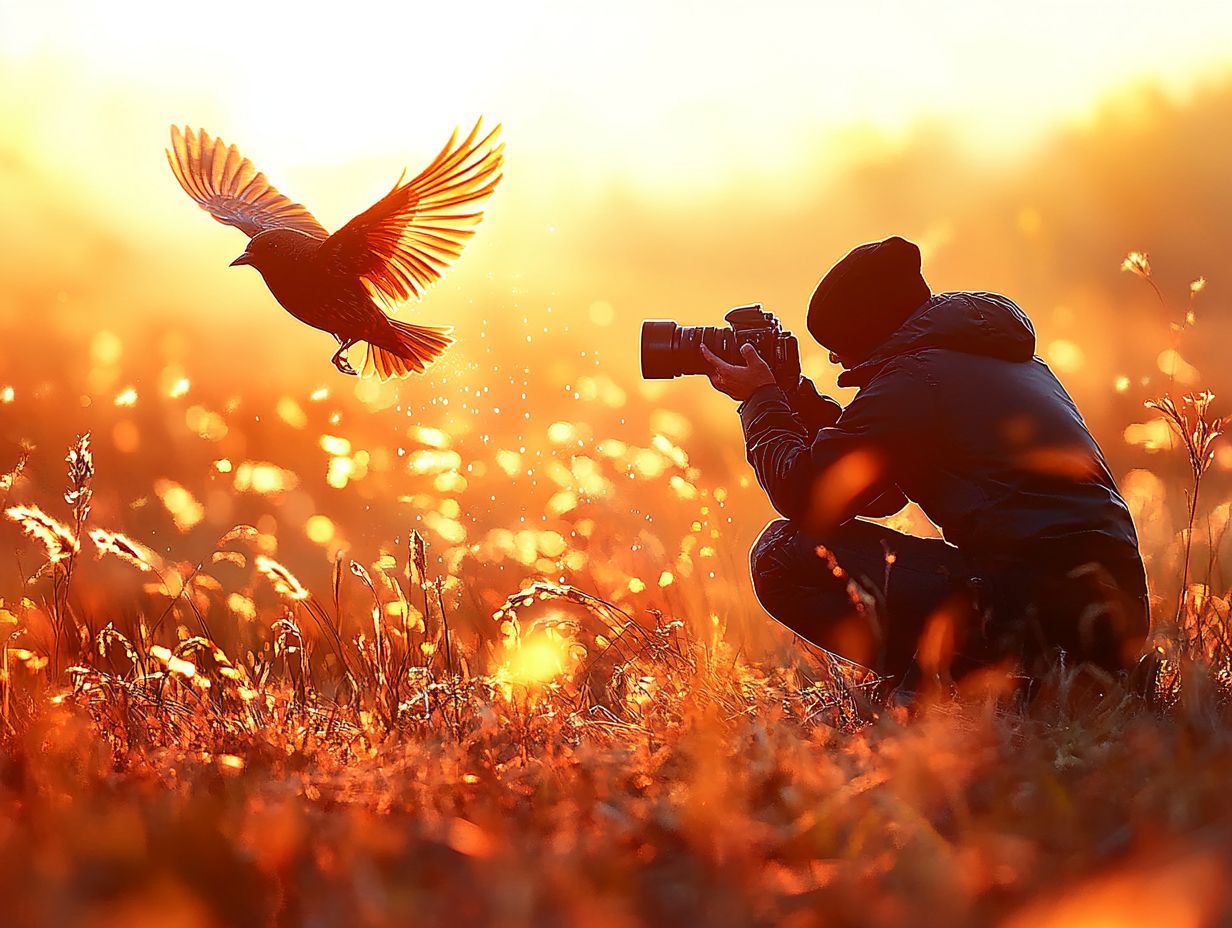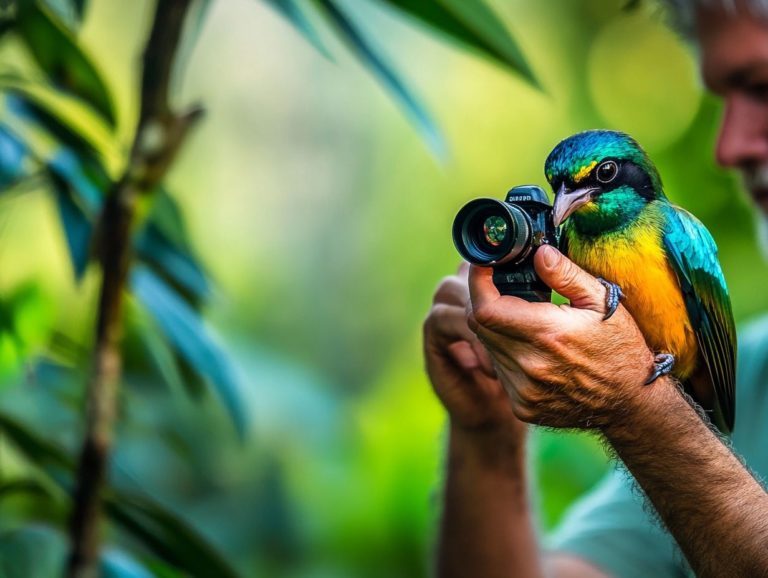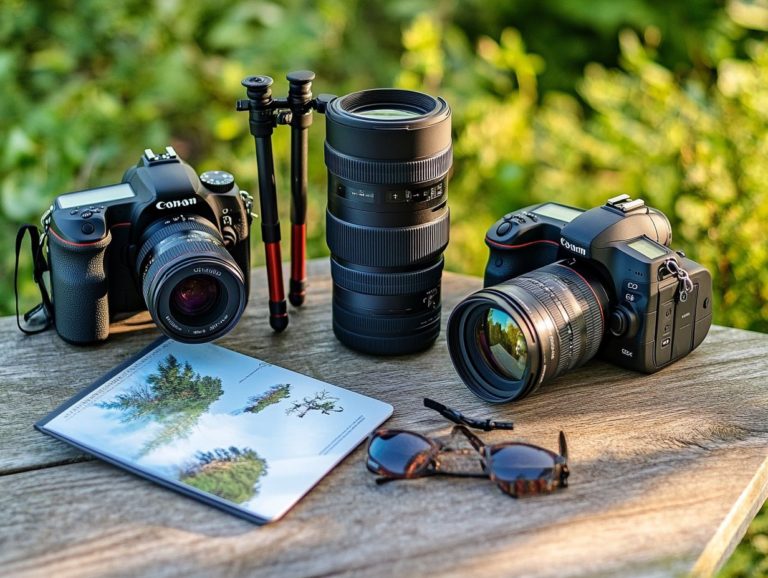How to Capture Action Shots of Birds
Bird photography opens up a captivating glimpse into the vibrant world of avian life, allowing you to seize fleeting moments of beauty and grace. It showcases the art of bird photography.
To capture breathtaking action shots, you need essential equipment, including the right camera and lens, along with accessories that elevate your photography, especially in wild bird photography.
Master techniques for understanding bird behavior, refining your composition, and utilizing optimal lighting conditions. These photography tips will greatly enhance your skills.
With insights on patience, persistence, and post-processing, you ll be well-equipped to showcase stunning images that truly capture the essence of birds in motion. Whether you’re a beginner or an expert, the journey is rewarding.
Contents
- Key Takeaways:
- Equipment Needed for Action Shots of Birds
- Techniques for Capturing Action Shots of Birds
- Tips for Successful Bird Photography
- Lighting and Timing
- Patience and Persistence
- Post-Processing for Action Shots of Birds
- Frequently Asked Questions
- What are some tips for capturing action shots of birds?
- How can I improve my composition when taking action shots of birds?
- Should I use continuous shooting mode for capturing action shots of birds?
- What is the best time of day to capture action shots of birds?
- What are some common mistakes to avoid when taking action shots of birds?
- Is it important to research the behavior and habits of the birds I want to photograph?
Key Takeaways:

- Invest in a quality camera and lens that can zoom in on distant subjects and has a fast shutter speed to capture crisp and detailed action shots of birds.
- Observe and understand bird behavior to anticipate and capture dynamic shots with interesting compositions and framing.
- Embrace patience and persistence; the rewards of bird photography are truly worth the wait. Use post-processing techniques to enhance and share your stunning bird photos with others.
Why Bird Photography?
Bird photography transcends mere hobby; it becomes an art form that beautifully captures the elegance and intricacies of avian life. Bird photography gives you an exciting opportunity to connect with nature while refining your skills in observing subjects and understanding bird behavior.
Whether you re wandering through the lush jungles of Manu National Park, exploring the vast landscapes of Kruger National Park, or soaking in the serene wetlands of the Everglades, these birding hotspots are brimming with chances to capture stunning images of birds in their natural habitats, supported by a reliable field guide.
For many, this pursuit envelops them in a profound sense of joy and serenity, enriching their emotional connection to the natural world. As you witness the graceful flight of a hawk or the vibrant plumage of a tropicbird, you may find yourself lost in the moment, deepening your appreciation for wildlife and the ecosystems that support it.
Utilizing resources like eBird can elevate this experience, enabling you to discover new locations, track sightings, and learn about various species. Whether it s a morning excursion to an urban park or a weekend getaway to the coast, each click of the shutter brings you closer to understanding the wonders of avian life.
Equipment Needed for Action Shots of Birds
Capturing stunning action shots of birds hinges on having the right equipment to achieve impressive results. Your choice of camera and lens plays a pivotal role in the quality of your images, especially in wild bird photography, where quick reflexes are essential for seizing fleeting moments. Learning about techniques for photographing birds in flight can greatly enhance your skills.
Understanding key equipment considerations, such as the ideal focal length for bird photography, the necessity of long lenses, and the benefits of teleconverters, can elevate your ability to photograph birds in flight or at feeding stations. This knowledge enhances your skills in action photography.
Master camera settings like shutter speed and autofocus to capture action effectively, whether using mirrorless cameras or used DSLRs. Learning how to use burst mode for bird shots ensures you can freeze action effectively in wild bird photography.
Don t miss your chance to capture that perfect moment! Grab your camera, hit the trails, and start photographing the beauty of avian life today!
Camera and Lens Requirements
The camera you choose for bird photography is crucial to capturing breathtaking images. The ideal focal length typically ranges from 300mm to 600mm. This range allows you to maintain a comfortable distance from your subjects while ensuring detailed captures.
Long lenses with teleconverters help you get closer shots. They are invaluable tools for bird photography. Whether you opt for a mirrorless camera or a used DSLR, each offers unique advantages. Understanding their specifications is key to optimizing your camera settings, including aperture and ISO, during your shoots.
Mirrorless cameras typically deliver faster autofocus and quieter operation, which can be critical for skittish subjects. A solid DSLR, on the other hand, often has superior battery life and a broader selection of well-established lenses.
Consider your shooting environment whether you’re in dense forests or wide-open fields. Each scenario may require different lens types, such as prime or zoom lenses. With this knowledge, you can choose a lens that fits your specific needs be it speed, versatility, or weight. This will greatly enhance your photographic experience and elevate the quality of your images.
Accessories for Better Results
The right accessories can elevate your bird photography results. A sturdy tripod system is essential for stability during long shoots. This allows you to frame your shots with precision while minimizing camera shake.
Consider investing in teleconverters, which help you take sharper photos of distant subjects. Beyond tripods, lens hoods are critical; they prevent lens flare and enhance contrast, making your images pop with vibrancy. Don t overlook filters, like polarizers, which can reduce glare and enrich the colors of feathers, adding depth to each photograph.
If you want to capture fluid movement while following birds in flight, gimbals offer a fantastic solution. They facilitate smooth panning and tilting, allowing for better action shots. Integrating these accessories not only enhances your images but also enables you to explore creative angles and perspectives, enriching the storytelling experience in your bird photography.
Techniques for Capturing Action Shots of Birds

Capturing stunning action shots requires both skill and great equipment. It s essential to develop a deep understanding of techniques specific to this captivating genre of photography.
By honing your skills in observing subjects and understanding bird behavior, you can anticipate their movements and position yourself for the perfect shot. This leads to better results in your wild bird photography. For those looking to improve their techniques, learning how to photograph migratory birds can be invaluable. Composition and framing are key elements in crafting compelling images, especially in action photography, where birds in flight offer limitless opportunities.
This insight allows you to tell stories through your images, beautifully showcasing the elegance and grace of avian life.
Understanding Bird Behavior
Understanding bird behavior is essential for capturing stunning images in wild bird photography, as it enables you to anticipate your subjects’ actions and apply the art of bird photography effectively. For those particularly interested in capturing rare moments, check out these tips for photographing rare bird species. By observing these birds in their natural habitats, you can uncover the various habits and patterns of different species, significantly enhancing your chances of seizing those unique moments.
This knowledge serves as the foundation for effective techniques in bird photography, allowing you to position yourself perfectly for when a bird takes flight, feeds, or interacts with its environment, particularly at feeding stations.
Take, for example, the captivating courtship rituals of certain species that yield breathtaking visuals. Others may display specific feeding techniques, such as hovering or diving, resulting in dynamic shots that can take your photography to the next level.
By staying attuned to these behaviors, you not only choose the right camera settings but also predict the perfect moment to press the shutter.
Understanding social interactions like flock formations or territorial displays can lead to breathtaking captures you won t want to miss! This deep connection with wildlife transforms your images into compelling and impactful stories that resonate with audiences, echoing the emotion captured by renowned photographers like Ben Hall.
Composition and Framing
Composition and framing are vital elements of action photography, particularly when capturing the vibrant essence of birds in flight or at play. For tips on achieving this, explore how to photograph birds with different backgrounds. A well-composed image captures your viewer’s attention and tells a story about the subject and its surroundings.
Techniques like the rule of thirds and leading lines can significantly enhance the visual appeal of your photographs. Paying close attention to background elements can elevate the overall impact of your composition. By observing your subjects closely, you can make real-time adjustments that lead to more compelling and dynamic images.
Don t hesitate to experiment with different angles and perspectives to elevate your bird photography. For example, shooting from a low angle can offer a more intimate glimpse into the bird’s habitat, emphasizing its size in relation to the surroundings.
Lighting is crucial; that soft, golden glow during the golden hour provides stunning backdrops that enhance colors and textures, making capturing birds in flight even more rewarding. Balancing these technical elements like focus and the distance between the nearest and farthest objects in a photo that appear sharp with your creative vision will result in striking images that resonate with viewers, showcasing not only the subjects but the rich stories they embody.
Tips for Successful Bird Photography
Successful bird photography relies on a blend of refined techniques, sharp observational skills, and insightful tips to elevate your shooting experience. One of the most vital aspects to grasp is how lighting and timing work together; the quality of natural light can significantly impact the results of your photographs.
Early mornings and late afternoons often present the ideal conditions for capturing birds, offering a soft glow that enriches colors and textures. Cultivating patience and persistence while waiting for that perfect shot can yield breathtaking images that truly capture the essence of avian life.
Lighting and Timing
Lighting and timing are critical elements that can make or break your bird photography, profoundly impacting the mood and quality of your images. Mastering natural light elevates the colors and textures in your photos, while knowing the best times to shoot generally early mornings or late afternoons results in softer, more flattering light.
Utilizing the right camera settings, such as shutter speed and autofocus, is essential for capturing fleeting moments. For those interested in urban wildlife, learning how to photograph birds in urban settings will provide insights that help you create striking, visually captivating images that beautifully showcase birds in their natural habitats.
In varying light conditions, it’s essential to adjust your exposure settings, including ISO, aperture, and shutter speed. For example, during bright daylight, a lower ISO and smaller aperture keep your images sharp. In low-light scenarios, like dense forests, you may need to increase the ISO to maintain clarity.
Being aware of the sun’s position will guide where to set up yourself and your camera, ensuring you capture the optimal light angles. The golden hour, just after sunrise or before sunset, provides perfect opportunities to create stunning silhouettes and vivid colors. Plan your shoots around these moments for enhanced photograph quality.
Patience and Persistence

In wild bird photography, patience and persistence are your best companions, often leading to great results. The perfect shot often means waiting quietly and observing birds for extended periods, significantly enhancing your chances of success.
Birds are unpredictable, and their behaviors may not always align with your expectations. Stay steadfast in your pursuit; your dedication can lead to stunning, unforgettable images and storytelling opportunities that beautifully showcase the wonders of avian life.
Picture yourself on a memorable outing, perched on a log with your camera ready, feeling as though time has come to a standstill. Just when you start to second-guess your decision, a vibrant kingfisher suddenly swoops down, its wings glistening in the early morning light.
That unexpected moment serves as a powerful reminder of the value of perseverance. Bring a small book to spark your creativity during long waits. Keeping a record of your experiences in a photography diary can further enhance your growth as a photographer.
Don t forget to breathe and soak in your surroundings immersing yourself in nature s symphony can transform the wait into a rewarding meditative experience, sharpening your focus and passion for the craft.
Post-Processing for Action Shots of Birds
Post-processing is essential for refining and enhancing your action shots of birds, allowing you to elevate your photography to a professional level. Techniques like cropping, adjusting exposure, and enhancing colors can transform ordinary images into captivating visual narratives, especially for action photography that captures the essence of motion.
With editing software at your fingertips, you have the power to correct imperfections and reveal the true beauty of your birds as captured through your lens. Sharing and showcasing your work on online platforms can help you connect with a broader audience and fellow enthusiasts, amplifying your impact in the photography community. Utilize platforms like eBird for sharing your findings and images.
Editing and Enhancing Images
Editing and enhancing images is an essential step in your bird photography journey. It allows you to fine-tune your compositions and maximize the visual impact of your shots.
By utilizing software tools to adjust exposure, color balance, and sharpness, you can bring out the intricate details of birds’ feathers and their vibrant colors. Photography tips focused on editing can guide you in cropping images for improved composition and removing distractions. This ensures that the bird remains the star of your photograph. Selecting the right lens categories will also contribute to the quality of your images.
To achieve these enhancements, it’s crucial to explore various editing software options like Adobe Lightroom or Capture One. Both offer intuitive interfaces and powerful features. Here s a straightforward step-by-step guide to help you along the way:
- Start by importing your images.
- Adjust the exposure to highlight those fine details.
- Fine-tune the color temperature to match the natural light conditions.
- Sharpen the image to help delineate the feather textures.
While this editing process can dramatically enhance your images, maintaining the authenticity of the scene is vital. Over-editing can lead to an unrealistic portrayal that detracts from the true beauty of these magnificent creatures and can undermine the art of bird photography.
Sharing and Showcasing Your Work
Sharing your work is essential don t miss out on connecting with fellow enthusiasts! It opens doors for you to connect with a wider audience. Platforms like Instagram, photography forums, and local exhibitions offer fantastic opportunities to display your images and gain invaluable feedback. You could showcase your work at locations like Kruger National Park or Everglades for wildlife photography.
A well-organized portfolio highlights your style. It showcases your skills effectively. A curated portfolio should reflect diverse themes, showcasing various species and environments to captivate a wide range of viewers, including migration patterns observed with platforms like eBird.
Building a supportive network within the bird photography community can significantly enhance your reach. Getting involved in local birdwatching clubs, online groups, or workshops leads to collaborative opportunities and insights from seasoned photographers. This enriches your practice and provides access to birding hotspots and expert advice on equipment considerations.
By actively participating in discussions, sharing experiences, and offering constructive feedback, you not only boost your own knowledge but also contribute to a vibrant community. It nurtures a shared passion for bird photography, enhancing your skills in action photography and birds in flight.
Frequently Asked Questions
What are some tips for capturing action shots of birds?

To capture action shots of birds, use a fast shutter speed to freeze the movement and get a sharp image. Using a telephoto lens helps you get close to the birds. For more tips on this, check out how to capture bird behavior on camera. Patience is also key while waiting for the perfect shot, along with understanding bird behavior.
How can I improve my composition when taking action shots of birds?
When composing your shot, consider the background and surrounding elements. Frame the bird in a way that creates a dynamic and interesting composition. To enhance your skills, learn how to take photos while bird watching and avoid any distracting elements in the background. A clear plan for your composition can greatly improve your photography skills, particularly for a beginning photographer.
Should I use continuous shooting mode for capturing action shots of birds?
Yes! Using continuous shooting mode greatly increases your chances of capturing the perfect action shot. It allows you to take multiple photos in quick succession, enhancing your chances of getting a sharp and well-timed image. This is especially effective when using autofocus features effectively.
What is the best time of day to capture action shots of birds?
The best times for bird photography are early in the morning and late in the afternoon. The light is softer and more flattering, making it easier to capture stunning action shots during the golden hour the hour after sunrise and before sunset.
What are some common mistakes to avoid when taking action shots of birds?
One mistake is not paying attention to the bird’s behavior. Expect their movements and be ready to capture the shot when it happens. For tips on capturing those perfect moments, check out how to create stunning bird portraits. A fast shutter speed is crucial to avoid blurry photos!
Is it important to research the behavior and habits of the birds I want to photograph?
Yes, researching the behavior and habits of your target birds is vital. Knowing when and where they are most active helps you plan your shots and catch their movements effectively!






